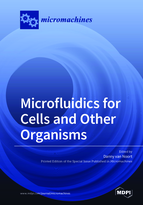Microfluidics for Cells and Other Organisms
A special issue of Micromachines (ISSN 2072-666X). This special issue belongs to the section "B:Biology and Biomedicine".
Deadline for manuscript submissions: closed (31 December 2018) | Viewed by 68017
Special Issue Editor
Interests: microfluidics; 3D cell cultures; human-on-a-chip; lab automation; biomedical engineering
Special Issues, Collections and Topics in MDPI journals
Special Issue Information
Dear Colleagues,
I would like to invite you to submit your research on cells and other organisms in microfluidics. Microfluidics-based devices play an important role in creating realistic microenvironments in which cell cultures can thrive. They can, for example, be used to monitor drug toxicity and perform medical diagnostics, and be in a static-, perfusion- or droplet-based device. They can also be used to study cell-cell, cell-matrix or cell-surface interactions. Cells can be either single cells, 3D cell cultures or co-cultures. Other organisms could include bacteria, zebra fish embryo, C. elegans, to name a few. In addition, research contributions on plant cells and plants in microfluidics are encouraged. However, we will not be considering cancer models, as that will be the subject for a separate Special Issue in Bioengineering later on.
This Special Issue will give you the opportunity to publish work that has not fully matured yet, but is worthwhile to be brought to the attention of other researchers and readers of the journal.
Dr. Danny van Noort
Guest Editor
Manuscript Submission Information
Manuscripts should be submitted online at www.mdpi.com by registering and logging in to this website. Once you are registered, click here to go to the submission form. Manuscripts can be submitted until the deadline. All submissions that pass pre-check are peer-reviewed. Accepted papers will be published continuously in the journal (as soon as accepted) and will be listed together on the special issue website. Research articles, review articles as well as short communications are invited. For planned papers, a title and short abstract (about 100 words) can be sent to the Editorial Office for announcement on this website.
Submitted manuscripts should not have been published previously, nor be under consideration for publication elsewhere (except conference proceedings papers). All manuscripts are thoroughly refereed through a single-blind peer-review process. A guide for authors and other relevant information for submission of manuscripts is available on the Instructions for Authors page. Micromachines is an international peer-reviewed open access monthly journal published by MDPI.
Please visit the Instructions for Authors page before submitting a manuscript. The Article Processing Charge (APC) for publication in this open access journal is 2600 CHF (Swiss Francs). Submitted papers should be well formatted and use good English. Authors may use MDPI's English editing service prior to publication or during author revisions.
Keywords
- Microfluidics
- Bacteria
- Cells
- Cell cultures
- Tissue
- Organisms
Related Special Issues
- Microfluidics for Cells and Other Organisms, Volume II in Micromachines (8 articles)
- Biomedical Microfluidic Devices 2020 in Micromachines
- Organisms-on-Chips in Micromachines (3 articles)







